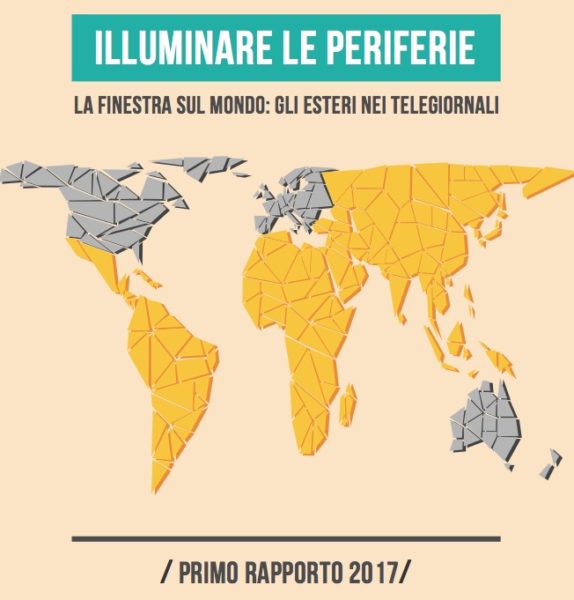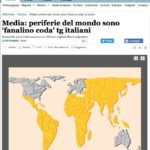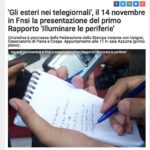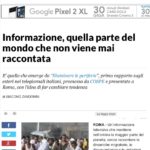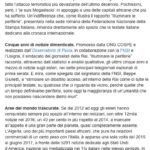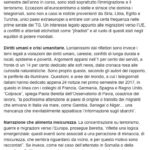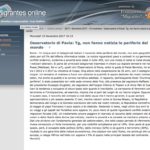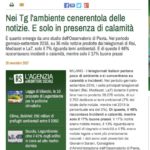The Italian news seem increasingly unprepared to tell the world and its current economic, political and social complexity. The various data emerging from the first report “Illuminating the suburbs of the world” presented by COSPE onlus, the Osservatorio di Pavia, Usigrai and FNSI could be summarized as follows.
A tool designed specifically for journalists and editorial offices: “This report is intended to be a working tool available to the editorial offices – says Vittorio Di Trapani, secretary of Usigrai – a goad, an incentive to return to being direct witnesses of the facts. And to do this we need to start from the suburbs: go back to living them. To understand them and tell them.”
The peripheries, considered both geographical and thematic, are in fact the rear of information in the years taken into consideration by the research (2012-2017) with 1% visibility (492 total news for an average of 7 news per month in all the newscasts) with a slight but further deterioration in the first half of this year (79 news from 2015 to the first half of 2017; 24 in 2017).
But it is not all foreign news that are disappearing. In fact, this sector, which from 2012 to 2017 achieved an average visibility of 19%, is even continuously increasing and peaks of 24% were already recorded in the six months examined in 2017.
But what are we talking about? Two phenomena in particular hold the ground: terrorism and migration. Since 2015, these two issues together with the politics associated with them have made up 70% of the foreign affairs agenda (respectively 25%, 15% and 30%).
How do we talk about it? The countries of the Western world are the protagonists of the foreign news agenda: 63% of the news concerns Europe and North America (43% and 20% respectively). Followed by Asia (12%), the Middle East (11%); remain marginal: Africa (9%), and Central and South America (5%).
Non-European countries ranking “high” in this classification, are always high in relation to conflicts (and consequent migrations, such as the case of Syria and Libya), or terrorism (the case of Turkey, for example). There are countries with less than ten news reports in two and a half years, such as Vietnam, the Central African Republic and Mauritania; others, such as Burundi, Algeria and Sierra Leone present in a single service.
Among the criteria that seem to guide the selection of foreign news are proximity, exceptionality, threat, simplicity of the narrative frame, the involvement of Westerners, the presence of testimonials, preferring those of Catholic origin.
The number of victims, other elements being equal, does not appear to be one of the criteria that guide coverage: the massacre of civilians in Yemen in 2015 was reported in 5 news reports, the one in Burkina Faso in 6 reports.
As far as the migration phenomenon is concerned, news in 2016 increased by over 70% compared to 2014. But the genesis of migrations, the reasons that push people to leave or to flee remain in the (media) dark.
The same insufficiency for in-depth news: only 26 news in over two years on endemic conflicts and forced migrations; 5 news for poverty and famine; 14 news on Pope Francis’ travels and appeals; 6 those on the violation of human rights and women’s freedom.
We are not alone however. The research also compares the main European public newscasts (in France, Italy, Germany, Great Britain and Spain) to discover that they have one common trait: Eurocentrism. Overall, the five European news outlets dedicate 45% of the news on the foreign page to Europe, followed, very far apart, by Asia, North America, Africa, South America and Oceania.
A somewhat sad picture, that places us from the point of view of information among provincial countries, which only look at their navel, and above all with a media system that contributes to fuelling an overly partial imaginary of the phenomena that surround us: “We are presented with a world that is “other” than ours – says Anna Meli of COSPE onlus in the introduction – where famines, natural disasters, escapes and migrations occur cyclically in an inescapable way. Whether they are due to political or environmental causes, little changes by now. On migrations, for example, today the information focuses a lot on the places of transit without being able to intercept the before and after, the places of origin and the stories and the routes of arrival; even on conflicts and terrorism the story is fragmented”.
Of the same opinion also Giuseppe Giulietti and Raffaele Lorusso respectively president and secretary of Fnsi who in the preface of the report write: “The multiplication of texts without “Contexts” determines a deficit of knowledge and understanding of the very dynamics that foresee and accompany the same phenomena linked to terrorism and migration. We see the effects, we give voice to the discomfort and fears, but we tell little about the causes that produce despair, flight, terror”.
The drafting of the annual report “Light up the suburbs” was created precisely to make a contribution to reflection in the world of Italian information and for this reason it is a joint initiative of the Unions of Journalists, FNSI and Usigrai, who have long been involved also on the issue of information quality, a qualified research body such as the Osservatorio di Pavia and an NGO such as COSPE, which has always placed at the centre of its action, in addition to international cooperation interventions, the action of stimulus and awareness of the Italian public opinion on the North-South imbalances and interdependencies.
The research, conducted and edited by Paola Barretta of the Osservatorio di Pavia, is divided into three parts that explore these first data presented in depth: the chronological analysis of foreign countries and suburbs from 2012 to 2017 (first semester), the qualitative suburbs with a focus on the war in Syria, the comparison between the main European newscasts on the foreign page and on the story of the suburbs.
A way to emphasize the need to work in the world of information with a critical conscience and attention to forgotten places, to the many injustices that are not mentioned, to the violations of human rights that remain hidden.
A tool, the report, which aims to become an annual occasion for reflection and exchange between the world of NGOs, research and media operators as a contribution to improving the quality of information and pluralism.
“It will be our care – conclude Giulietti and Lorusso again in the preface to the volume – to report it to all the regional associations so that it becomes a tool for comparison and, in agreement with the Order of Journalists and with Usigrai, promote real professional refresher courses, capable of developing knowledge and awareness”.
